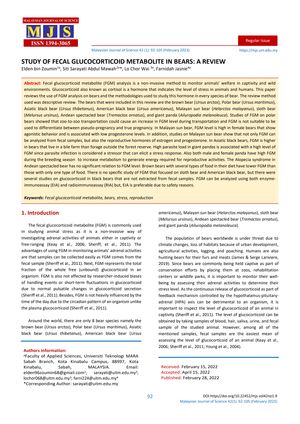Study of Fecal Glucocorticoid Metabolite in Bears: A Review
February 2023
in “
Malaysian Journal of Science. Series B, Physical & Earth Sciences
”

TLDR Analyzing bear poop helps measure their stress without harming them.
This review paper discusses the use of fecal glucocorticoid metabolite (FGM) analysis as a non-invasive method to assess stress levels in various species of bears. It covers the brown bear, polar bear, Asiatic black bear, American black bear, Malayan sun bear, sloth bear, Andean spectacled bear, and giant panda. Key findings include the increase in FGM levels in polar bears during zoo-to-zoo transportation, high FGM levels in Malayan sun bears with agonistic behavior and low progesterone, and higher FGM in Asiatic black bears in bile farms compared to those foraging in the wild. High parasite loads in giant pandas correlate with high FGM levels, and both sexes exhibit high FGM during breeding season. No significant relationship was found between FGM levels and alopecia syndrome in Andean spectacled bears. Brown bears with varied diets have lower FGM levels. No specific FGM studies on sloth bears and American black bears were found, although other types of glucocorticoid studies exist for the latter. FGM can be measured using enzyme-immunoassay (EIA) and radioimmunoassay (RIA), with EIA being preferred for safety reasons.
